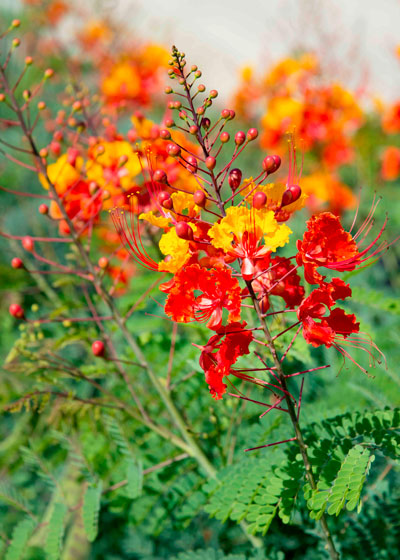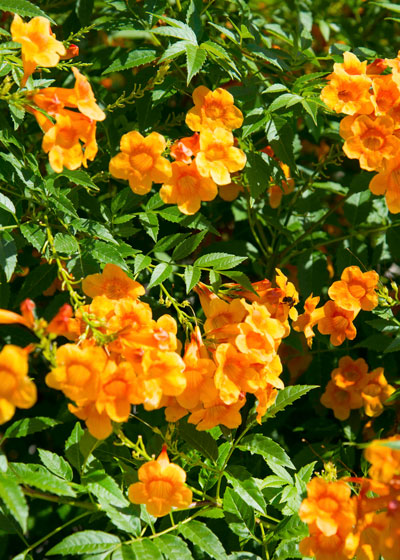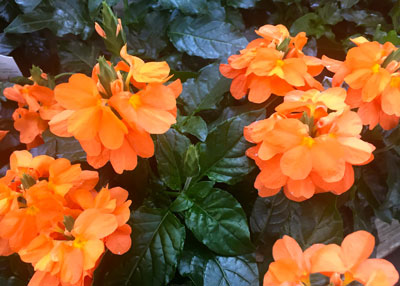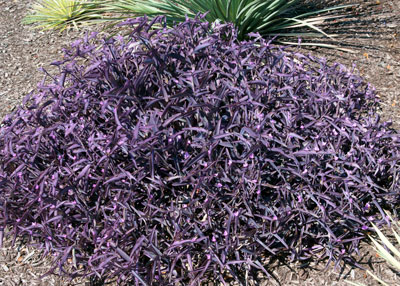Orange You Glad I Featured These!

Pride of Barbados and Orange Jubilee Esperanza dazzle in North Texas median a couple of years ago.
It’s kinda hard for a kid who grew up in College Station to find anything good to say about orange flowers, but folks, the three I’ve brought to you today transcend all of that. These are downright gorgeous.

Pride of Barbados brings a real tropical look to its surroundings.
Pride of Barbados
Pride of Barbados goes first. It’s the closer of the two orange-flowering beauties in the top photo above. Also called red Mexican bird of paradise, it’s botanically Caesalpinia pulcherrima. You’ll see it frequently the farther south you go in Texas (not as often in settings like this in North Central Texas). It’s used with great abundance in Austin and San Antonio and southward, and Tiger Swallowtails abound around it.

If you love Gold Star Esperanza, you’ll be just as fond of its cousin Orange Jubilee.
Orange Jubilee Esperanza
Farther east in the median photo above you see Orange Jubilee Esperanza. It’s now given its own species name, Tecoma alata according to Arizona State University. That sets it apart from Gold Star Esperanza, a long-proven and highly popular Texas performer that’s a selection of Tecoma stans. Orange Jubilee grows to be 4 to 6 feet tall and wide (larger toward the Gulf Coast, and its trumpet-shaped flowers keep coming all summer and way into fall.
Both of these plants require full sun and heat to meet their potential. With regular watering via a working drip irrigation system, they are basically sources of no-care color. While they may or may not survive winters as far north as the Metroplex (especially in raised median beds), they certainly will come back for gardeners in the southern half of the state.

Look at those glossy leaves – perfect backdrop for its luscious flowers.
Crossandra
You won’t find this one growing outdoors very often. It’s more of a patio pot that you grow on a table or use to decorate an entryway. It looks fabulous combined with pumpkins and other fall decor. Its leaves are incredibly glossy and dark green, and the graceful floral spikes are the color of cooling orange sherbet. It blooms for weeks at a time, then more spikes are sent up to continue the show.
Keep crossandras in bright light indoors, but out of direct sunlight when you put them outside during the hot weather. Keep them moist at all times, and use a high-nitrogen, water-soluble plant food to nourish them, applying it every month or so during the growing season. Protect them from temperatures below 40F by bringing them onto a bright window in the bathroom or kitchen.

Purpleheart is used as a warm-season perennial groundcover.
Purpleheart, but we’ll call it “maroonheart”
OK. We’ll throw this one in for our Aggie fans. Purpleheart performs like the sorbet between spicy courses of a fine meal. It’s a relative of wandering Jews, but unlike those cousins, purpleheart (Setcreasea pallida) is winter-hardy in almost all of our state. It dies to the ground, but it re-emerges the following spring to provide great color for a groundcover. It, too, loves sun and heat, and it, too, seems to have no pests that bother it.
